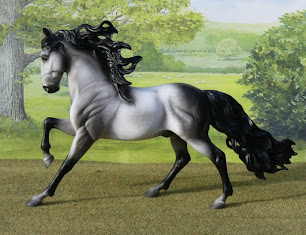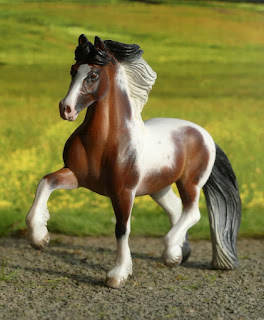I think reading horsey fiction is pretty universal for anyone who grows up loving horses. Whether you've got your own, ride at a riding school, or just adore horses without ever getting much contact with the real thing, pony stories have always been a part of that obsessive phase which so many of us have as children or young teens, and not all of us grow out of.
There's horsey books to suit just about every kind of horsey child, and my favourites were the Jinny at Finmory series by Patricia Leitch - they didn't have the tweedy, jolly poshness of the typical pony story, the 'horsey set' I'd never come into any contact with, and couldn't identify with. Jinny's world was easier to relate to - things went wrong, real life got in the way, and ponies weren't perfect : they were difficult things, stubborn and dirty and sometimes badly behaved, and you couldn't just snap your fingers and have all the tack and equipment you wanted, it was realistic mucky down-to-earth horse-owning on a budget. And central to every story in the series was the bond between Jinny and her horse, Shantih - a strained, stressful thing of love and worry, joy and panic, which everyone who's ever owned a much-loved but difficult horse must've been through, too.
Recently I've been having a chat about the books with a couple of model horse friends who'd loved them as well, fished my copies out, and ended up re-reading them - I think some others in the series must've been library borrowings, because I've definitely read more than I've got here.
And, of course, I loved them all over again : the beautiful, lyrical quality of the writing makes them an absolute pleasure to read, the horse characters as strongly drawn as the humans, and the setting so atmospherically brought to life you can almost feel the wind from the moors. The nostalgia is strong, too, written in the 1970s they're utterly evocative of an era which isn't quite 'historical' yet, but has definitely gone from most places any modern teen would ride.
One thing which came up, as to be expected in any discussion between model horsey people, was the markings on the horses posing as Shantih for the cover photos (you can see a good informative post about them here). In the text, Shantih is described as having a white face and four socks, making the first model the most accurate, but the second one caught my eye more, the stallion Prince of Orange - not only does he have a nice quirky face marking, but he's got a chestnut patch inside his white sock, which is pretty rare to see.
By the time I'd finished the first two or three books, the idea of painting a mini Shantih had settled in my mind, and this weekend I dug through my body box to find an SM-scale arabian I knew was in there. A while ago, I'd filed down the ears to a better length, carved the legs thinner and hooves smaller, refined the throat and jawline, and filed a bit off each overly chunky shoulder, but never picked a colour and so it went unpainted. Now, I had an idea, some reference photos on the book covers, and plenty of orange paint (I've run out of a couple of colours, but not my 'chestnut' pot), so it was time to get to work...and here she is!

I'm very pleased with her, after knowing this fictional horse for about 25 years it's kind of satisfying having a little version, but I'm already thinking she needs a little black highland Bramble to keep her company! I don't tend to paint all that many chestnuts, finding it can be a bit of a plain colour unless they have a lot of shading and contrast, but the markings on this one make her that little bit more interesting to look at, even if you don't know the character.
I did google 'Breyer Shantih', 'model horse Shantih' and 'Shantih custom', just to make sure I wasn't making a direct copy of anyone else's model version, but oddly couldn't find any others - there were models named Shantih, but none of them chestnut arabian customs which could've been done as portraits. You'd think such a popular fictional horse would've been painted many times over, but if so, they're hiding from google!
A couple more angles to show the markings, and I even found a bit of suitable background scenery (though admittedly it came out of a connemara's box, not a highland, so it's the wrong nationality of stone wall and moorland!)
So there we have it, my own little Shantih, in painted plastic form. I wonder if any other fans of books might happen to find this post. Did you ever read them? Or did you have different favourites? Do let me know in the comments!























